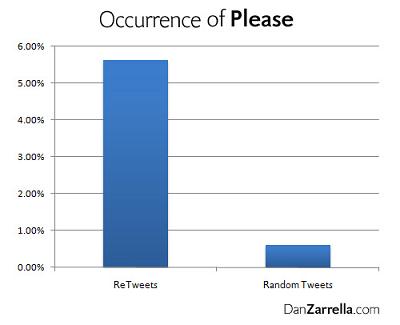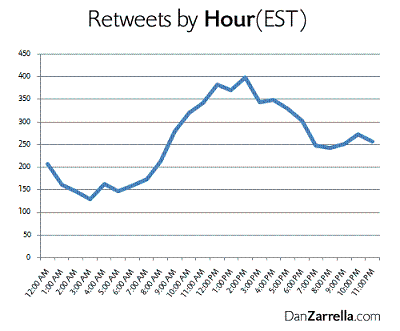
« PREVIOUS ENTRY
Why Gay Talese does his reporting on “laundry board”

What’s a “ReTweet”? It’s when somebody copies one of your Twitter status updates and puts it in their own stream. It has thus become the new coin of the realm in measuring online influence: If your utterances on Twitter are getting ReTweeted a lot, then you can brag lustily about your awesome Web 7.0 street cred. Tens of thousands of Twitterophiles each day stare forlornly at that empty box on the Twitter page, wondering what they can say — in 140 characters or less — that will suddenly go viral and sweep the globe.
Well, wonder no more! Over at the Mashable blog, viral-marketing expert Dan Zarella did some fascinating research into “the science of ReTweets.” Because Twitter has a very open and generous API to their enormous firehose of everyday Tweets, anyone can grab the data and try to parse it for patterns. Zarella decided to look at ReTweeting amongst a sample of 20,000 users to see if he could spy any rules. So what did he find?
Firstly, he discovered that the identity of the original Twitterer isn’t the be-all and end-all. You might imagine that getting ReTweeted is simply a matter of being a huge Twitter celebrity with 15,000 followers; with so many people paying attention to your Tweets, it would stand to reason that you’d have a much greater likelihood of your utterances going viral, right?
That’s true, Zarella found — but only to a degree. If you control for the number of followers someone has — and thus compare Tweets to Tweets on an equal basis — then the content of the Tweet is actually more important than the identity of the person who originally wrote it. What specific type of content was most likely to be ReTweeted? Original stuff — bits of news and information that is exclusive to the original Twitterer. In particular …
- Calls to action (as in: “please ReTweet”), while they might sound cheesy, work very well to get ReTweets.
- Timely content gets ReTweeted a lot.
- Freebies are popular.
- Self-reference (Tweeting about Twitter) works.
- Lists are huge.
- People like to ReTweet blog posts.
The most ReTweeted words and phrases were, in order, “you”, “twitter”, “please,” “retweet”, “post”, “blog”, “social,” and “free”. Indeed, as Zarella points out, saying “please” is very powerful — “polite calls to action” have a high incidence of getting ReTweeted. We’re social beings; we like to help out!
The final intriguing trend he found is time of day. It turns out Twitter is currently governed by the circadian rhythms of Eastern Standard Time — because the amount of ReTweeting overall starts at a low level in the predawn period EST, then climbs during the workday and peaks at 3 pm. (Check out the chart after the jump.)
So if you want to get really well ReTweeted? Tweet something with nifty original content, ask if people will “please” pass it around, and post at 9 am EST.
One of the things that fascinated me about Zarella’s work here is that it appears to support Duncan Watts’ debunking of the idea that viral spreading of trends, memes or utterances is dependent upon “influentials” — incredibly well-connected people who are all-important “hubs” in the social network. (I wrote about his work last year in Fast Company.) The “two-step” theory of influence, developed in the 50s and popularized in Malcolm Gladwell’s The Tipping Point, is that these superinfluential folks are key to the spread of a big trend. Watts doubted this was true, and developed some mathematical models and real-world experiments that cast a lot of doubt on the idea that “influential” people can really have that much influence. And indeed, Zarella seems to have found that being an “influential” on Twitter — i.e. having tons of followers — isn’t as important as the quality and content of the message.

I'm Clive Thompson, the author of Smarter Than You Think: How Technology is Changing Our Minds for the Better (Penguin Press). You can order the book now at Amazon, Barnes and Noble, Powells, Indiebound, or through your local bookstore! I'm also a contributing writer for the New York Times Magazine and a columnist for Wired magazine. Email is here or ping me via the antiquated form of AOL IM (pomeranian99).

ECHO
Erik Weissengruber
Vespaboy
Terri Senft
Tom Igoe
El Rey Del Art
Morgan Noel
Maura Johnston
Cori Eckert
Heather Gold
Andrew Hearst
Chris Allbritton
Bret Dawson
Michele Tepper
Sharyn November
Gail Jaitin
Barnaby Marshall
Frankly, I'd Rather Not
The Shifted Librarian
Ryan Bigge
Nick Denton
Howard Sherman's Nuggets
Serial Deviant
Ellen McDermott
Jeff Liu
Marc Kelsey
Chris Shieh
Iron Monkey
Diversions
Rob Toole
Donut Rock City
Ross Judson
Idle Words
J-Walk Blog
The Antic Muse
Tribblescape
Little Things
Jeff Heer
Abstract Dynamics
Snark Market
Plastic Bag
Sensory Impact
Incoming Signals
MemeFirst
MemoryCard
Majikthise
Ludonauts
Boing Boing
Slashdot
Atrios
Smart Mobs
Plastic
Ludology.org
The Feature
Gizmodo
game girl
Mindjack
Techdirt Wireless News
Corante Gaming blog
Corante Social Software blog
ECHO
SciTech Daily
Arts and Letters Daily
Textually.org
BlogPulse
Robots.net
Alan Reiter's Wireless Data Weblog
Brad DeLong
Viral Marketing Blog
Gameblogs
Slashdot Games